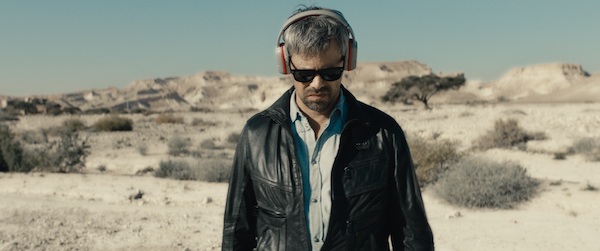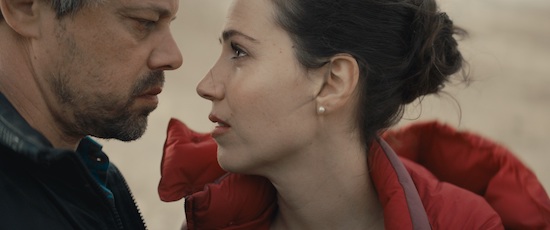Ahed’s Knee: An Artist’s Rage

Ahed’s Knee, the latest feature from Israeli filmmaker Nadav Lapid, is a visually inventive, emotionally engaging work about an artist’s rage against censorship and a citizen’s frustration over his country’s direction. Told over the course of one day, the film depicts Y (a moodily charismatic Avshalom Pollak), a filmmaker who travels to a remote desert village to promote one of his films. The title refers to Ahed Tamimi, a real-life Palestinian activist who was detained by Israeli authorities after slapping a soldier. The controversial Tamimi is the subject of a video project Y has begun casting; we see some audition clips, including one actor’s rendition of “Welcome to the Jungle.” (Music plays a huge part in Lapid’s film.) Throughout, the camera moves restlessly, swooping, circling and swinging side to side, sometimes mirroring a character’s point of view, sometimes just creating a state of frenetic energy.
The host of the screening in the Arava is an employee from the Ministry of Culture (Nur Fibak), an attractive, flirtatious young woman who is a huge fan of Y’s work. They become friendly and she casually mentions a form he must sign in order to get paid for the appearance. The form, which limits the topics he can discuss, becomes a symbol of everything Y detests about his country.

Though the story is about Y’s despair over what he believes is the crumbling state of Israel, Lapid’s film is a tour de force of visual and aural style, a series of road-trippy vignettes that are often beautiful and sometimes powerful. Especially striking are scenes set in the desert, its moonscape-like stillness a great backdrop for Y’s wanderings. He periodically sends video messages to his mother, with whom he collaborates on his films; her recent cancer diagnosis has compounded his emotional turmoil. In one scene, he walks and dances (as does the camera) through the desert, the bright soul-pop on his headphones creating an odd juxtaposition. At another point, he happens upon a rock duo performing in a shed-like building, and he’s clearly moved by the music. Throughout the film, music is used very effectively, as when a middle-age driver tells Y of his marriage to a young woman. A fantasy scene ensues, featuring the man dancing to Bill Withers’ “Lovely Day.” Often played almost in their entirety, songs are more than mere snippets, emphasizing their importance.

Toward the end of Ahed’s Knee, Y describes his military service to Yahalom, and we see him as a young soldier in several flashbacks, a couple of which are music video-like scenes of soldiers moshing to hardcore punk and female soldiers dancing with machine guns. Eventually, Y tells her of a traumatic incident that occurred during that time.
As the film builds to Y’s incendiary appearance at the screening and its aftermath, Ahed’s Knee becomes tense and very dramatic as we wonder if Y has gone too far. Visually delightful and profound in parts, Ahed’s Knee is a wild trip that is worth taking.
Ahed’s Knee is available on all major PVOD platforms.
—Marina Zogbi

